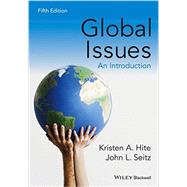Now reorganized and updated throughout, the fifth edition of this well-regarded introductory global issues text continues to reflect the most important aspects of an increasingly globalized world.
- Reorganized into more accessible chapters better suited to semester-long courses, with new sections covering development, climate change, pollution, and governance
- The only survey-level text in the field to unite the perspectives of geography, political science, sociology, ecology, international relations, economics, and development studies
- Moves beyond the international to be truly global in focus, with coverage of topics such as wealth and poverty, population, food, energy, natural resources, and technology
- Incorporates new case studies and examples, including the Fukushima nuclear disaster, the effects of changing water supply on migration, natural gas fracking, and smart grid technology
- Offers a dynamic and accessible narrative with many student-friendly features, such as chapter boxes, a glossary of terms, guides to further reading, media and Internet resources








